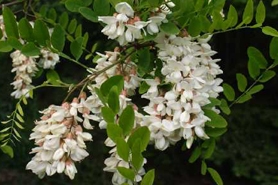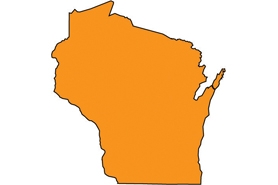BLACK LOCUST
(Robinia pseudoacacia)
Fast-growing tree in the legume family, growing 30-90’ tall with a trunk 2-4’ in diameter. Forms multiple-stemmed clones and are slow to grow leaves in the spring. Seedlings and small branches have paired thorns. The bark is smooth and green on saplings, but dark with deep furrows on mature trees.
Other names for this plant include:
- Common names: false acacia, robinia.
- Scientific names: Robinia pseudo-acacia.
Classification in Wisconsin: Restricted (all cultivars exempt)
- Ecological Threat
-
- It Invades forests, upland prairies and savannas, pastures, old fields and roadsides.
- Its vigorous vegetative reproduction forms extensive, dense groves of clones that exclude native vegetation.
- Damage to roots or stems (such as from fire, wind, cutting, or disease) stimulates vigorous sprouting, root suckering and lateral spread.
- Identification
-
Leaves: Alternate, pinnately compound with 7-21 leaflets, arranged in pairs with one unpaired leaflet at the tip. Leaflets are thin, entire, elliptic, bluish-green above and pale beneath.
Flowers: White, pea-like, and very fragrant flowers form showy, drooping inflorescences. Bloom in mid-spring.
Fruits & seeds: Flat, shiny brown pods, 2-6” long, contain 4 to 8 seeds. Pods often persist on trees through winter.
Roots: Extensive system of fibrous roots and shallow rhizomes. Reproduces vegetatively by root suckering and stump sprouting.
- Control
- Mechanical:
- Neither cutting nor girdling alone are effective to kill a clone; they stimulate stump and root sprouting or suckering.
- Burning and mowing can temporarily control the spread of young shoots from a parent tree or clone; however, mowing can promote seed generation and burning can stimulate sprouting.
- All black locust stems in a clone must be treated for a chemical treatment to be effective.
- Foliar spray trees under 8’ tall, basal bark treat trees over 8’ tall or all trees under 4” dbh, chainsaw girdle/treat or cut/treat trees over 8’ tall and over 4” dbh.
- Foliar spray with metsulfuron-methyl or clopyralid during mid-summer.
- Basal bark with triclopyr ester in a band at least 6 inches high all around the stem at approximately 12 inches from the ground.
- Apply clopyralid, triclopyr or glyphosate to a girdle cut at standing height or to cut stumps from late summer into the dormant season.
For more information on control techniques, visit the Black locust factsheet [exit DNR] by University of Wisconsin-Extension.
- Resources
- Sources for content:
- Czarapata, Elizabeth; Invasive Plants of the Upper Midwest: an illustrated guide to their identification and control. University of Wisconsin Press. 2005. Pg. 41-43
- Heim, Jim. Illinois Natural History Survey. Black Locust [exit DNR].
- Wieseler, Susan. Plant Conservation Alliance, Alien Plant Working Group. Least Wanted: Black locust [exit DNR] Last revised June 27, 2006.



